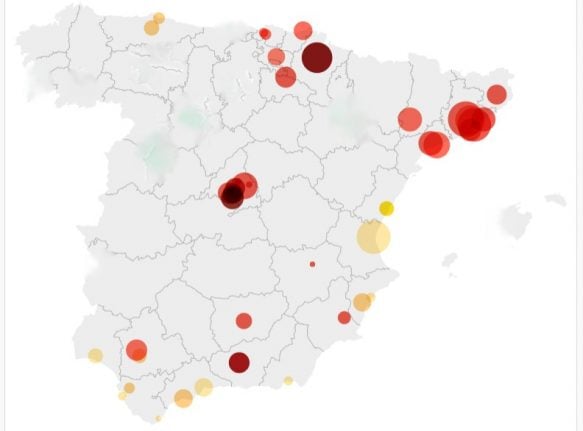Spanish Health Minister Salvador Illa said on Tuesday that the state of alarm declared in the Madrid region last Friday will remain in place until there is a significant drop in coronavirus transmission rates.
The criteria to introduce restrictions included a cumulative incidence rate of above 500 cases per 100,000 people over a 14 day period and would be applied to those cities with a population above 100,000.
But despite Madrid’s rate falling to below 500 cases per 100,000 from a peak of 750 according to data reported by the Madrid health authorities, Spain's Health Minister insisted that wasn’t enough.
“The cumulative incidence has to drop a lot more, not just below 500 cases, but to below at least 200, and ideally below 100,” he said.
Looking at the figures across Spain reveals that at least 34 cities have an incidence rate above the 200 threshold.
Of the 63 cities that have above 100,000 residents in Spain there was no up-to-date information for nne of them because of regional authorities in Aragón, Baleares, Cantabria, Castilla y León, Extremadura and Galicia had not reported the data.
But of those that did post data, 34 cities reported a cumulative incidence rate of at least 200 cases per 100,000 people.
Click on the interactive map below to see the data for each city with dots ranging from yellow to red to illustrate the infection rate from lowest to highest. Green dots show those cities for which there was no recent data to compare.
Under existing Health Ministry’s rules, a municipality with a population above 100,000 must impose new restrictions if all of three conditions are met and these are: if the cumulative incidence of Covid-19 over 14 days rises above 500 cases per 100,000 inhabitants; if more than 10 percent of PCR tests conducted in the zone are confirmed positive and if a threshold of 35 percent of intensive care beds are occupied by coronavirus patients.
So far only Madrid and nine satelite towns around it have been confined under the state of alarm but authorities in Castilla y León introduced confinement measures in the municipalities of León, Palencia and San Andrés del Rabanedo under the orders approved by a majority of regional communities two weeks ago.
Navarra has introduced new restrictions limiting gatherings to six people, and closing bars and restaurants by 10 pm as well as limiting their capacity to 30 percent, but they have stopped short of a perimetre lockdown in Pamplona, the city with the highest infection rate in the whole of Spain.
Catalonia is preparing to announce new restrictions after a spike in infections in Barcelona and across the northeastern region while in Andalusia, health authorities imposed restrictions on university students in Granada after a surge of infections were blamed on students flouting social distancing rules during weekend parties.
The Andalusian government has also increased restrictions on movement in the municipality of Écija in Seville due to an outbreak and will close bars and restaurants in Sierra de Yeguas in Málaga.
To find out the cumulative incidence rate (IA in Spanish) in any municipality in Spain consult this interactive map produced by Maldita.es below.
READ MORE:
- Two Spanish regions impose new Covid restrictions
- Q&A: What you can and can’t do under Madrid’s State of Emergency rules



 Please whitelist us to continue reading.
Please whitelist us to continue reading.
Member comments